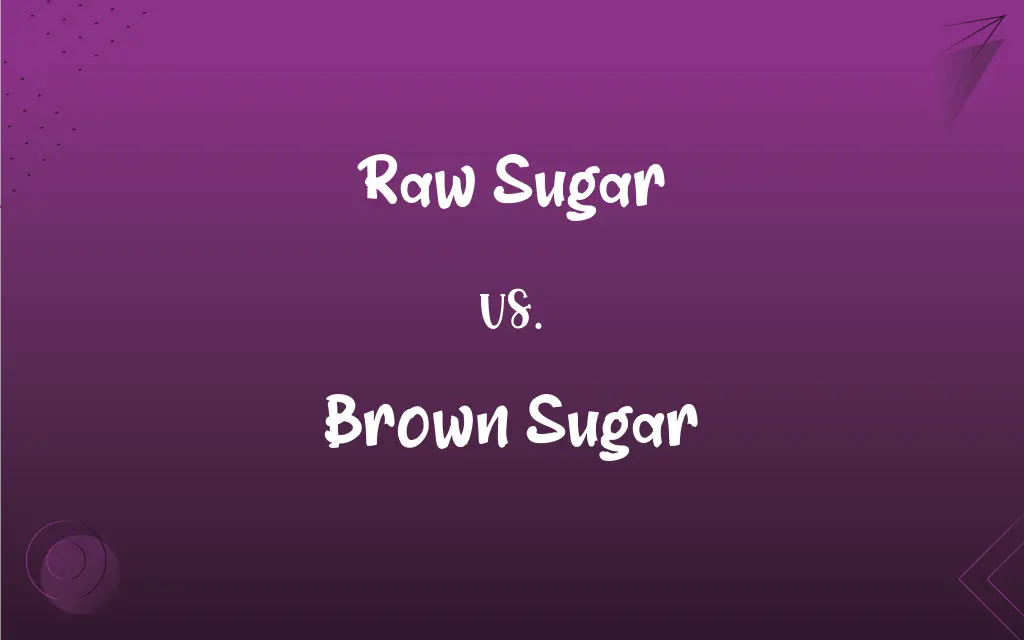Raw Sugar vs. Brown Sugar: What's the Difference?
Edited by Aimie Carlson || By Harlon Moss || Updated on October 22, 2023
Raw sugar is minimally processed sugar from sugarcane juice, while brown sugar is either raw sugar with molasses added or refined white sugar with molasses added.

Key Differences
Raw sugar and brown sugar, both derived from sugarcane, have distinctive characteristics and uses in culinary applications. Raw sugar, as its name implies, undergoes minimal processing, retaining some natural molasses. This type of sugar is often seen as a golden-brown crystal, known for its somewhat crunchy texture and slight molasses flavor. On the other hand, brown sugar can be produced in two ways: either by refining raw sugar and then reintroducing molasses or by simply adding molasses to refined white sugar.
While raw sugar is often praised for being closer to its natural state due to its limited processing, brown sugar offers a moist, clump-like consistency that is favored in certain recipes. Brown sugar, particularly because of the added molasses, brings a deep, rich flavor and color to dishes. It's this molasses content that primarily distinguishes brown sugar from raw sugar.
Furthermore, when it comes to usage in recipes, brown sugar's moistness can impact the texture and moisture of baked goods, making them softer and chewier. Raw sugar, with its coarser texture, is often sprinkled on top of pastries or used in beverages, where its distinctive flavor can shine.
Interestingly, the health differences between raw sugar and brown sugar are minimal. Both types of sugar contain similar calorie counts per serving and have comparable effects on blood sugar levels. Though raw sugar might be perceived as healthier because it's less processed, both should be consumed in moderation.
Comparison Chart
Processing
Minimally processed
Refined and combined with molasses
ADVERTISEMENT
Color
Golden-brown
Light to dark brown, depending on molasses content
Texture
Coarse, crunchy crystals
Moist, often clumpy
Flavor
Slight molasses flavor
Rich molasses flavor
Main Use in Cooking
Sprinkling on pastries, beverages
Baking for softer, chewier texture
Raw Sugar and Brown Sugar Definitions
Raw Sugar
Sugar that undergoes limited refining.
Many consider raw sugar a more natural sweetening option.
ADVERTISEMENT
Brown Sugar
Either raw sugar refined and mixed with molasses or white sugar with molasses added.
She was out of white sugar, so she used brown sugar for the cake.
Raw Sugar
A coarse, golden-brown sweetener.
For a rustic touch, she decorated the cookies with raw sugar.
Brown Sugar
Sugar combined with molasses, giving it a brown color.
The cookie recipe calls for one cup of brown sugar.
Raw Sugar
An alternative to more heavily processed sugars.
He swapped the white sugar for raw sugar for a change in flavor.
Brown Sugar
Sweetener known for its rich, deep flavor.
The caramel sauce had a richer taste thanks to the brown sugar.
Raw Sugar
A sugar product minimally processed from sugarcane.
The coffee tasted better with raw sugar sprinkled on top.
Brown Sugar
A moist, often clumpy sugar variety.
She broke apart the clumps in the brown sugar before measuring.
Raw Sugar
Sugar crystals retaining some natural molasses.
She prefers the slight molasses flavor of raw sugar in her tea.
Brown Sugar
Sugar commonly used in baking for chewier results.
Brown sugar brownies are her specialty because of their soft texture.
FAQs
Is raw sugar healthier than brown sugar?
Both have similar calorie counts and effects on blood sugar, so neither is significantly healthier.
Which sugar retains more natural molasses: raw sugar or brown sugar?
Raw sugar retains some natural molasses, while brown sugar has molasses added.
Can I substitute raw sugar for brown sugar in recipes?
It can be done, but it may affect the flavor, color, and texture of the dish.
Are raw sugar and brown sugar the same?
No, raw sugar is minimally processed, while brown sugar has added molasses.
Does raw sugar have a distinct taste?
Yes, raw sugar has a slight molasses flavor.
Why might someone choose raw sugar over brown sugar?
Some prefer raw sugar for its minimal processing, coarser texture, and slight molasses flavor.
Can I use brown sugar to sweeten my coffee?
Yes, brown sugar can sweeten coffee, offering a rich molasses flavor.
Which is coarser: raw sugar or brown sugar?
Raw sugar is coarser with larger crystals.
Is raw sugar always brown?
Raw sugar is generally golden-brown but can vary slightly in color.
How do I store raw sugar to maintain its quality?
Store raw sugar in a cool, dry place, and keep it sealed to prevent moisture absorption.
Is brown sugar just raw sugar with added molasses?
Brown sugar can be made from raw sugar with added molasses or from refined white sugar with molasses added.
Why does brown sugar form clumps?
The moisture from the molasses in brown sugar can cause it to clump over time.
Can I make my own brown sugar using raw sugar?
Yes, by adding molasses to raw sugar, you can make your own brown sugar.
Which sugar is better for making cookies soft: raw sugar or brown sugar?
Brown sugar, because of its moisture content, tends to make cookies softer.
What gives brown sugar its color?
The molasses content gives brown sugar its distinctive color.
What's the main use of brown sugar in cooking?
Brown sugar is commonly used in baking for its ability to produce a softer, chewier texture.
Is raw sugar vegan?
Most raw sugar is vegan, but it's always best to check the product label or with the manufacturer.
Which sugar is moister: raw sugar or brown sugar?
Brown sugar is moister due to its molasses content.
How can I prevent my brown sugar from hardening?
Store it in an airtight container and consider adding a slice of bread or an apple slice to maintain moisture.
Is there a difference in sweetness between raw sugar and brown sugar?
Both sugars are sweet, but brown sugar has a richer flavor due to the molasses.
About Author
Written by
Harlon MossHarlon is a seasoned quality moderator and accomplished content writer for Difference Wiki. An alumnus of the prestigious University of California, he earned his degree in Computer Science. Leveraging his academic background, Harlon brings a meticulous and informed perspective to his work, ensuring content accuracy and excellence.
Edited by
Aimie CarlsonAimie Carlson, holding a master's degree in English literature, is a fervent English language enthusiast. She lends her writing talents to Difference Wiki, a prominent website that specializes in comparisons, offering readers insightful analyses that both captivate and inform.































































